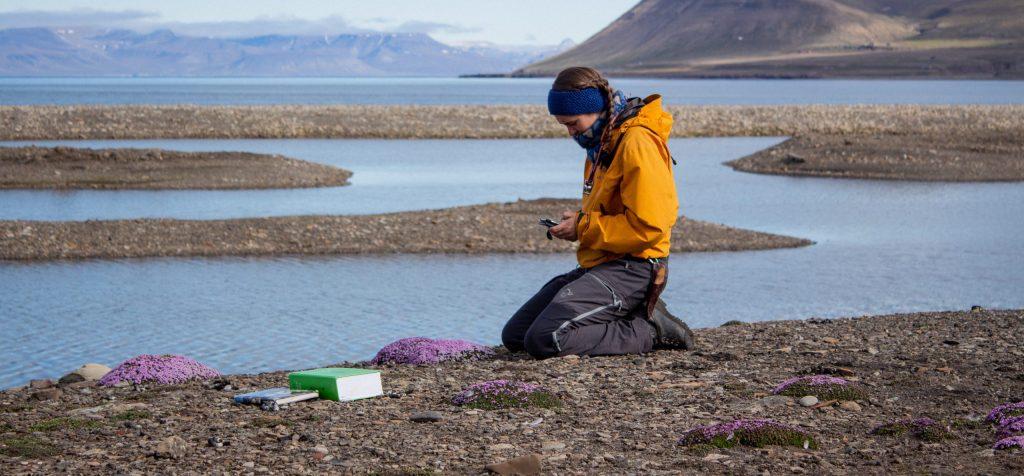• Learning Arctic Biology •
Want to learn about Arctic terrestrial biology?
Video: Tina Dahl and Marcos Poricres
• Browse by topic •
• Digital Tools •
360° Virtual Field Guides
Explore a variety of locations and learn about its biology, history and more. All in 360 degrees!
ArtsApp - Digital Key
A digital key for Svalbard’s flora, with specific keys for vascular plants and grasses.
Read about...
Systematics of fungi
Modern fungal systematics is based upon genetic analysis. However, and structure of the hyphal cells are also important. Below you will find an overview of
Arctic – a young biome with a dramatic history
The location of the Arctic within the Earth system combined with its particular climate history, have provided unique settings for the current flora and fauna
Inventory of Svalbard species
The endemic aphid Acyrthosiphon svalbardicum on Dryas octopetala. Image from Blomstrandhalvøya, Kongsfjord, towards Stuphallet. Photo Steve Coulson A provisional inventory of the terrestrial and freshwater
Ecosystem functions of invertebrates
The group invertebrate contains a great diversity of taxa and groups; from hard-bodied insects to soft bodied organisms such as worms. Given this diversity it

Archaea
Compared to Bacteria and Eukaryotes, Archaean diversity, physiology and ecology is still very little explored. Many Archaea are extremophiles – living in extreme environments –
Plant-insect phenology and physiological synchrony
The impact of insect herbivores on Arctic plants is known to be dismissable (Roslin et al. 2013); however, successful Arctic herbivores need to ensure they
Current status of freshwater systems in Svalbard
There has recently been published a summary of the available knowledge of freshwater systems in Svalbard. With permission from the authors (John E. Brittain, Ann
Bryophyte habitats
Bryophytes are found throughout the world from the harsh environments of Antarctica to the lush conditions of the tropical rainforests. Despite their small size, they
Microbiology in the Arctic
Since the turn of the previous century, when Arctic explorers began to return samples of microbes for culture and study, our understanding of the microbiology
Ecosystem role of bryophytes
Bryophytes have many important ecosystem functions in the Arctic. These include: Regulation of hydrology In many habitats, bryophytes control soil and vegetation hydrology (Beringer et
Microbial eukaryotes
Microbial eukaryotes are an evolutionary diverse group that gathers various eukaryotic organisms of often microscopic sizes, such as protist and fungi. Protists, comprise a large
Viruses
What is a virus? Viruses are infectious agents that replicate exclusively within a living cell. Viruses can infect all types of organisms, from animals and
What are bryophytes?
Evolutionary origin Bryophytes belong to the embryophytes, which include all land plants. Evidence from structural, biochemical, and molecular data supports the view that bryophytes and all
Fungi in Svalbard
A large number of mushroom species grow in Svalbard. Most are small, some are poisonous, while others are edible and tasty. Fungi have most of
Fungi in the Arctic Environment
Fungi are heterotrophic organisms feeding by osmotrophy. Their ecology can be divided into saprotrophs, parasites and mutualists. However, transitions exist between all these groups. Most
Biogeography of bryophytes
History The Pleistocene is the world’s recent period of repeated glaciations between 2.5 million to 11700 years ago. More than 20 cycles of glaciation occurred
Useful learning resources

bioCEED resource for learning statistics, tutorials for the statistical computing language R and more!
How do you start with academic writing? This is the prefect resources for those who are about to write their first thesis/poster/essay etc. or looking for new tips when it comes to academic writing.
Svalbox is all about Svalbard geology. Svalbox aims to compile and acquire key data sets and publications to provide an interactive 3D geoscientific database of Svalbard.
The UNIS Executable Books page provides an overview of all eBooks available and/or used for teaching at the University Centre in Svalbard (UNIS).










